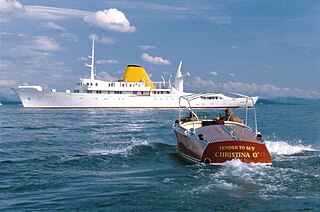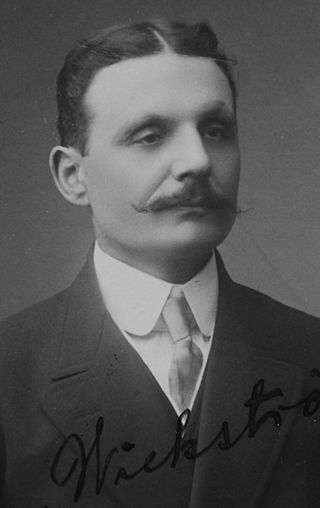| Company type | Private Limited Company |
|---|---|
| Industry | Boatbuilder |
| Founded | 1928 |
| Founder | Clyde Rummney |
| Headquarters | Detroit, United States of America |
Area served | Great Lakes |
| Products | Motor boats |
Clyde Boats was a small, privately owned, custom boat company located in Detroit, Michigan. For nearly fifty years it produced custom mahogany motorboats for clients in the Great Lakes area.
Clyde Boats was founded in 1928 in the living room of founder Clyde Rummney's Michigan home near the shores of Lake St. Clair. Mr. Rummney's first boats were small rowboats made primarily for himself and friends. By the early 1930s Mr. Rummney had relocated to Gibraltar, Michigan, and soon began renting space in a small building on Livernois Avenue in Detroit where he switched from row boats to producing custom-order mahogany boats with outboard engines.
Clyde Boats were soon available in three sizes; 12', [1] 14', and 16'. [2] Each boat began as a wooden "tub" constructed of moulded plywood and built by fishermen in Nova Scotia. [3] Some were Ashcroft hulls, with the inner and outer layer running on the same bias, overlapping the seams, while others were cold molded hulls. The boats were soon known for their speed, compared to other boats of their size. The secret was 5 Ply Moulded Marine Aircraft Birch, which was very light, and strong. At the Clyde factory the keel was added, then the boat would be completed using the customer's choice of accessories. At first, all boats were made to order, with no "tub" or supplies purchased until an order was placed, but by World War II the company had begun using the winter months when business was slow to construct boats to a factory standard that could be sold as factory models, or finished with additional details of the customer's choosing.
By the start of World War II Clyde Boats was building and selling around 40 boats a month. The factory building was soon purchased by Clyde Rummney. While competitors like Chris-Craft moved to larger production facilities and greater output, Clyde Boats remained small, with only three or four employees. Clyde Rummney himself did most of the designing, building, and selling of his products. Little effort was made to promote Clyde Boats beyond the Detroit area. The small size and exclusive nature of the company's products was attractive to many of its clients, and helped Clyde Boats maintain its reputation for exclusive, custom-made mahogany boats for the wealthy. It also kept overhead to a minimum, and, as the company's prices rose, so too did its profits.
Unlike its competitors, Clyde Boats did no military work during World War II. Its small size left it unattractive for military contracts and allowed the company to continue producing the exclusive mahogany boats its customers demanded, while other companies that relied on higher output were forced to produce military products because of reduced consumer demand. On the contrary, demand for Clyde Boats actually rose during the War years due to the unavailability of boats from other manufacturers. By the end of World War II Clyde Rummney was forced to move his company to a larger production facility down the road at 8600 Livernois Avenue, which he purchased outright.
By the early 1950s Clyde Boats was secure in its position as a unique custom boat builder in the Detroit area. Its clientele were often repeat buyers, purchasing their second or third Clyde boats. The company continued to manufacture the same 12', 14' and 16' models, though each continued to be produced with unique details to satisfy the customer's demands. The diversity of outboard engines also meant greater power was available, though many Clyde Boats were purchased without engines, which were added later by the owner. A small number of standard models built during the winter continued to be available.
Clyde Boats continued its operations, using largely the same methods and tools right up until its closing in 1971. Like many cottage businesses, it closed its doors with the retirement of its owner, Clyde Rummney, who lived only two more years after the closing, and died in 1973.
All Clyde Boats were finished in natural mahogany. None were ever painted at the factory. The Company's logo was a flying seagull with the word "CLYDE" in block letters across it.
Never common, even in the Detroit area, Clyde Boats are very rare today. Total production figures have been lost, but the company claimed to have built over 10,000 boats total from 1928 until closing in 1971.

Packard was an American luxury automobile company located in Detroit, Michigan. The first Packard automobiles were produced in 1899, and the last Packards were built in South Bend, Indiana in 1958.

A runabout is any small motorboat holding between four and eight people, well suited to moving about on the water. Characteristically between 20' and 35' in length, runabouts are used for pleasure activities like boating, fishing, and water skiing, as a ship's tender for larger vessels, or in racing. Some common runabout types are bow rider, center console, cuddy boat and walkaround. The world's largest runabout, Pardon Me, is 48 feet long and owned by the Antique Boat Museum in Clayton, New York.

The Plymouth Reliant and Dodge Aries are mid size cars introduced for model year 1981 as the first "K-cars" manufactured and marketed by the Chrysler Corporation. The Reliant and Aries were the smallest cars to have the traditional 6 passenger 2 bench seat with column shifter seating arrangement favored by customers in the United States, similar to larger rear-wheel drive cars such as the Dodge Dart and other front-wheel drive cars such as the Chevrolet Celebrity. The Reliant was powered by a then-new 2.2 L I4 SOHC engine, with a Mitsubishi "Silent Shaft" 2.6 L as an option. The Reliant was available as a 2-door coupe, 4-door sedan, or as a 4-door station wagon, in three different trim lines: base, Custom and SE. Station wagons came only in Custom or SE trim.

BRP Inc. is the holding company for Bombardier Recreational Products Inc., operating as BRP, a Canadian manufacturer of snowmobiles, all-terrain vehicles, side by sides, motorcycles, and personal watercraft. It was founded in 2003, when the Recreational Products Division of Bombardier Inc. was spun off and sold to a group of investors consisting of Bain Capital, the Bombardier-Beaudoin family and the Caisse de dépôt et placement du Québec. Bombardier Inc., was founded in 1942 as L'Auto-Neige Bombardier Limitée by Joseph-Armand Bombardier at Valcourt in the Eastern Townships, Quebec.

Mercury Marine is a marine engine division of Brunswick Corporation headquartered in Fond du Lac, Wisconsin. The main product line is outboard engines. It also produces the MerCruiser line of sterndrives and inboard engines. Some manufacturing is in Fond du Lac, while 40-60 HP engines are made in China. Smaller engines are Tohatsus that have been rebadged.

Chris-Craft Boats was an American boats manufacturer founded by Christopher Columbus Smith (1861–1939). The company was sold by the Smith family in 1960 to NAFI Corporation, which changed its name to Chris-Craft Industries in 1962. The current successor is Chris-Craft Corporation, which produces motorboats under the Chris-Craft name.

A yacht tender is a vessel used for servicing and providing support and entertainment to a private or charter yacht. They include utilitarian craft, powered by oar or outboard motor, and high-speed luxury craft, supporting superyachts, powered by inboard engines, some using water-jets. Some superyachts have a support vessel that follows them with bulky items that are not conveniently stowed aboard the main yacht, such as a helicopter, automobile or larger watercraft.

The word Drascombe is a trademark that was first registered by John Watkinson who applied it to a series of sailing boats which he designed and built in the period 1965–79 and sold in the United Kingdom (UK). They comprised the Coaster, Cruiser Longboat, Dabber, Drifter, Driver, Gig, Launch, Longboat, Lugger, Peterboat, Scaffie, Scaith and Skiff, together with a few other one-offs. They have wide and deep cockpits, adaptable boomless rigs and high bulwarks.
Fairey Marine Ltd, latterly known as FBM Marine, was a boat building company based on the River Hamble, Southampton, England. The company was created in the late 1940s by Sir Charles Richard Fairey and Fairey Aviation's managing director, Mr. Chichester-Smith. Both were avid sailing enthusiasts along with Chichester-Smith's good friend and former Olympic yachtsman, Charles Currey.

Chris-Craft Corporation is an American manufacturer of recreational powerboats that is based in Sarasota, Florida. Since June 4, 2018, the company has been owned by Winnebago Industries, an American manufacturer of recreational vehicles.
Noble & Cooley is an American musical instruments manufacturing company based out of Granville, Massachusetts. Having been established in 1854, it is the oldest drum company in the United States and is one of the oldest in the world. Having manufactured toy drums at the beginning, Noble & Cooley soon entered the professional drum market.

SS Ste. Claire is a steamer located in Detroit, Michigan. Built in 1910, she was one of the last propeller-driven excursion steamers to be operated on the Great Lakes. She was declared a US National Historic Landmark in 1992. In 2018, a devastating fire destroyed the upper decks, leaving only the steel structure. The ship was delisted as a National Historic Landmark and from the National Register of Historic Places in 2023.

Mayea Boat & Aeroplane Works is an American wooden boat builder based in Michigan. The company was founded in 1911 by Louis T. Mayea and represents the oldest family-run custom mahogany speedboat builder/designer in the United States. While all other early wooden speedboat builders have changed owners, shut their doors, or turned to fiberglass construction, Mayea Boat & Aeroplane Works continues the wooden speedboat tradition with direct lineage to the company's founder.

The Lincoln Motor Company Plant was an automotive plant at 6200 West Warren Avenue in Detroit, Michigan, later known as the Detroit Edison Warren Service Center. The complex was designated a National Historic Landmark in 1978, due to its historic association with World War I Liberty engines and the Lincoln Motor Company. However, the main structures were demolished in 2003 and NHL designation was withdrawn in 2005.

Hacker-Craft is the name given to boats built by The Hacker Boat Co. It is an American company, founded in Detroit, Michigan in 1908 by John Ludwig Hacker and is one of the oldest constructors of wooden motor boats in the world. The company moved operations to New York State in the 1970s and continues to produce hand-built boats.
The Norman Thompson Flight Company was a British aircraft manufacturer specialising in the construction of flying boats. It was formed as the White and Thompson Company in 1912, and designed and built the Norman Thompson NT.4 patrol aircraft and the N.T.2B flying boat trainer for the Royal Naval Air Service during the First World War, but production problems led to the company entering receivership in 1918, being liquidated in 1919.

The Russell Industrial Center is an industrial factory turned to commercial complex of studios and shops that is located at 1600 Clay Street in Detroit, Michigan. The Russell Industrial Center is a 2,200,000-square-foot (200,000 m2), seven building complex, designed by Albert Kahn for John William Murray in 1915. It contains studios and lofts and serves as a professional center for commercial and creative arts.

John Wickström was a Finnish-Swede engineer and entrepreneur.

The Siren 17 is a Canadian trailerable sailboat, that was designed by Hubert Vandestadt as trailer sailer and first built in 1974.
The Welch Motor Company was an American automobile company headquartered in Chelsea, Michigan. It started in 1901 and continued production of luxury vehicles until 1911 when it merged with General Motors.